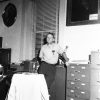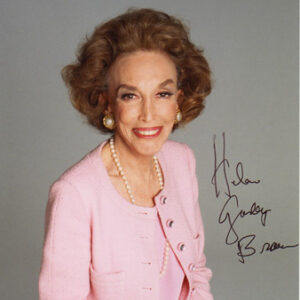calsfoundation@cals.org
Helen Marie Gurley Brown (1922–2012)
Helen Gurley Brown was a native Arkansan whose career includes landmark achievements in advertising and publishing. She was considered a spokesperson for the women’s liberation movement and sexual revolution in the mid-twentieth century as author of the bestselling book Sex and the Single Girl (1962) and editor-in-chief of Cosmopolitan magazine.
Helen Marie Gurley was born on February 18, 1922, in Green Forest (Carroll County) to a family of modest means. Her father, Ira Gurley, finished law school in 1923 and was soon elected a state legislator. The family moved to Little Rock (Pulaski County) and settled in the Pulaski Heights neighborhood. In 1932, as her father was preparing to run for Arkansas secretary of state, he was killed in an elevator accident at the Arkansas State Capitol. While her mother, Cleo Gurley, attended typing school and took in sewing, Helen Gurley was able to play with friends at the Little Rock Country Club during the years she attended Pulaski Heights Junior High. In 1937, when Gurley was fourteen, the family moved to Los Angeles, California. A few months later, Gurley’s sister Mary was stricken with polio. Gurley attended John H. Francis Polytechnic High School, where she was in the top ten percent of her class academically.
After high school graduation in 1939, she attended Texas State College for Women (now Texas Woman’s University) in Denton but was forced to withdraw after one semester for financial reasons. She then returned to Los Angeles, where she enrolled at Woodbury Business College (now Woodbury University), graduating in 1941. When Gurley was twenty-four, her mother and sister returned to Arkansas to live with her mother’s family in Osage (Carroll County), but she remained in Los Angeles, visiting Arkansas only occasionally. Gurley’s opinion of her home state was rarely very high. Noting the relative lack of anti-Semitism in Arkansas, for example, Gurley wrote, “We were pretty busy with Apartheid.”
In 1948, she took a secretarial job with the Los Angeles advertising firm of Foote, Cone and Belding, where she worked for advertising executive Don Belding and advanced to writing copy. She rose rapidly in advertising, winning three Frances Holmes Advertising Copywriters awards and becoming one of the nation’s highest-paid copywriters. She joined the Los Angeles advertising agency of Kenyon & Eckhardt in 1958 as copywriter and account executive.
The following year, at age thirty-seven, she married movie producer David Brown, who went on to produce such films as The Sting (1973), Jaws (1975), Cocoon (1985), and Driving Miss Daisy (1989). With her husband’s encouragement, she documented her memories of her time as an unmarried woman and, in 1962, published the book Sex and the Single Girl. It became an immediate bestseller, was turned into a movie, and revolutionized the perception of a single woman from a sad spinster to the “glamour girl of our times.” It covered beauty, dating, finance, work, and sex—a subject previously off limits to a proper unmarried woman. Along with assuring her readers that sex could be natural, respectable, and healthy, she underscored the importance of what came to be known as self-esteem. A full, rich life was not determined by great beauty, brains, or money, she said, but rather by a woman’s belief in herself, her willingness to develop her own potential, and her protest against remaining content as a quiet little “mouseburger.” In a time when women were expected to remain in the home, Brown emphasized the vital importance of paid, meaningful, continuing outside employment for women as a means to achieve those goals.
Brown and her husband drafted plans for a magazine aimed at eighteen- to thirty-four-year-old single women. In 1965, she was named editor-in-chief of the existing Cosmopolitan magazine and implemented their plan, moving the publication away from its staid, serious image and transforming it into an upbeat, glitzy, high-profile magazine glorifying the “Cosmo Girl.” Her advocacy of the liberated woman and “having it all” played a significant part in what is termed the sexual revolution.
Brown published ten books, including Sex and the Office (1964), Helen Gurley Brown’s Outrageous Opinions (1966), Sex and the New Single Girl (1970, an updated version of her first book), Having It All (1982), The Late Show: A Semi-Wild but Practical Guide for Women Over 50 (1993), The Writer’s Rules (1998), I’m Wild Again (2000), and Dear Pussycat (2004).
In 1985, Brown established the Helen Gurley Brown Research Professorship in magazine publishing at Northwestern University in Chicago. In 1988, she was inducted into the Publishers’ Hall of Fame; in 1995, she received the Henry Johnson Fisher Award from the Magazine Publishers of America; and in 1996, she was named to the American Society of Magazine Editors’ Hall of Fame. She resigned as editor-in-chief at Cosmopolitan in 1997, remaining at the helm of its international editions.
In 2000, Brown and her husband visited Arkansas, where they were met in Little Rock by Governor Mike Huckabee and Secretary of State Sharon Priest. Priest, who held the office Helen’s father planned to run for before his death, presented Brown with a packet of photos and other information pertaining to her father’s service in the Arkansas General Assembly. In Arkansas, the Browns were planning to look at gravesites.
Her husband David Brown died of kidney failure at their home in New York City on February 1, 2010, at age ninety-three. In 2012, Brown gave $30 million to the Columbia University Graduate School of Journalism and the Stanford University School of Engineering to establish the David and Helen Gurley Brown Institute for Media Innovation.
Brown died on August 13, 2012, in New York following a brief hospitalization. In 2013, during an unusual May snowstorm, her ashes were laid to rest next to her husband’s in the Sisco family cemetery near Route 103 in Osage.
For additional information:
Berebitsky, Julie. “The Joy of Work: Helen Gurley Brown, Gender, and Sexuality in the White-Collar Office.” Journal of the History of Sexuality 15 (January 2006): 89–127.
Brown, Helen Gurley. I’m Wild Again. New York: St. Martin’s Press, 2000.
———. Sex and the Single Girl. New York: Barnes & Noble, Inc., 2004.
Falkof, Lucile. Helen Gurley Brown: The Queen of Cosmopolitan. Ada, OK: Garrett Educational Books, 1991.
Fox, Margalit. “Gave ‘Single Girl’ a Life in Full (Sex, Sex, Sex).” New York Times, August 14, 2012. Online at http://www.nytimes.com/2012/08/14/business/media/helen-gurley-brown-who-gave-cosmopolitan-its-purr-is-dead-at-90.html?pagewanted=1&_r=1&hp (accessed July 24, 2025).
Hauser, Brooke. Enter Helen: The Invention of Helen Gurley Brown and the Rise of the Modern Single Woman. New York: HarperCollins, 2016.
Helen Gurley Brown Papers, 1938–2004. Sophia Smith Collection. Women’s History Archives. Smith College, Northampton, Massachusetts.
Hirshey, Gerri. Not Pretty Enough: The Unlikely Triumph of Helen Gurley Brown. New York: Sarah Crichton Books, 2016.
Scanlon, Jennifer. Bad Girls Go Everywhere: The Life of Helen Gurley Brown. New York: Oxford University Press, 2009.
Nancy Hendricks
Arkansas State University










Helen Gurley Brown played a role in bringing about a movie version of Jaws by recommending the book to her husband, film producer David Brown, who then co-produced the film with Richard Zanuck. David Brown and Richard Zanuck had each heard about Peter Benchley’s novel Jaws. David Brown came across it through a brief synopsis in Cosmopolitan magazine, which was edited by his wife, Helen Gurley Brown. She had passed on the synopsis to him, suggesting it could make a good movie.